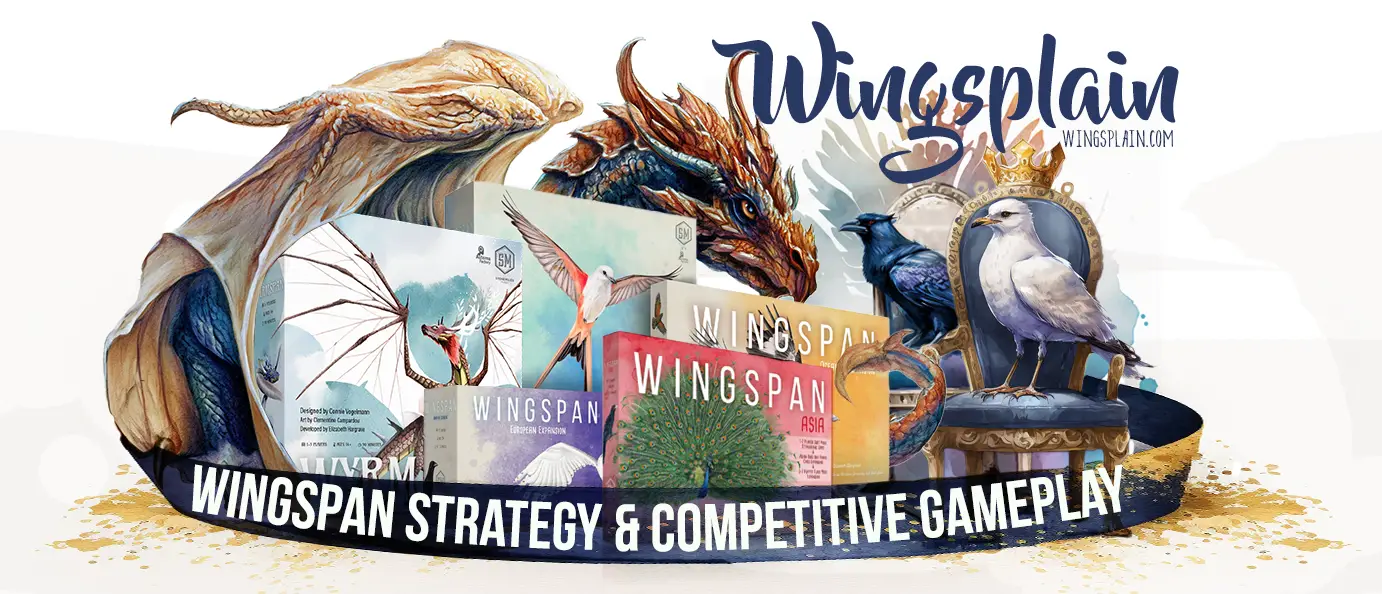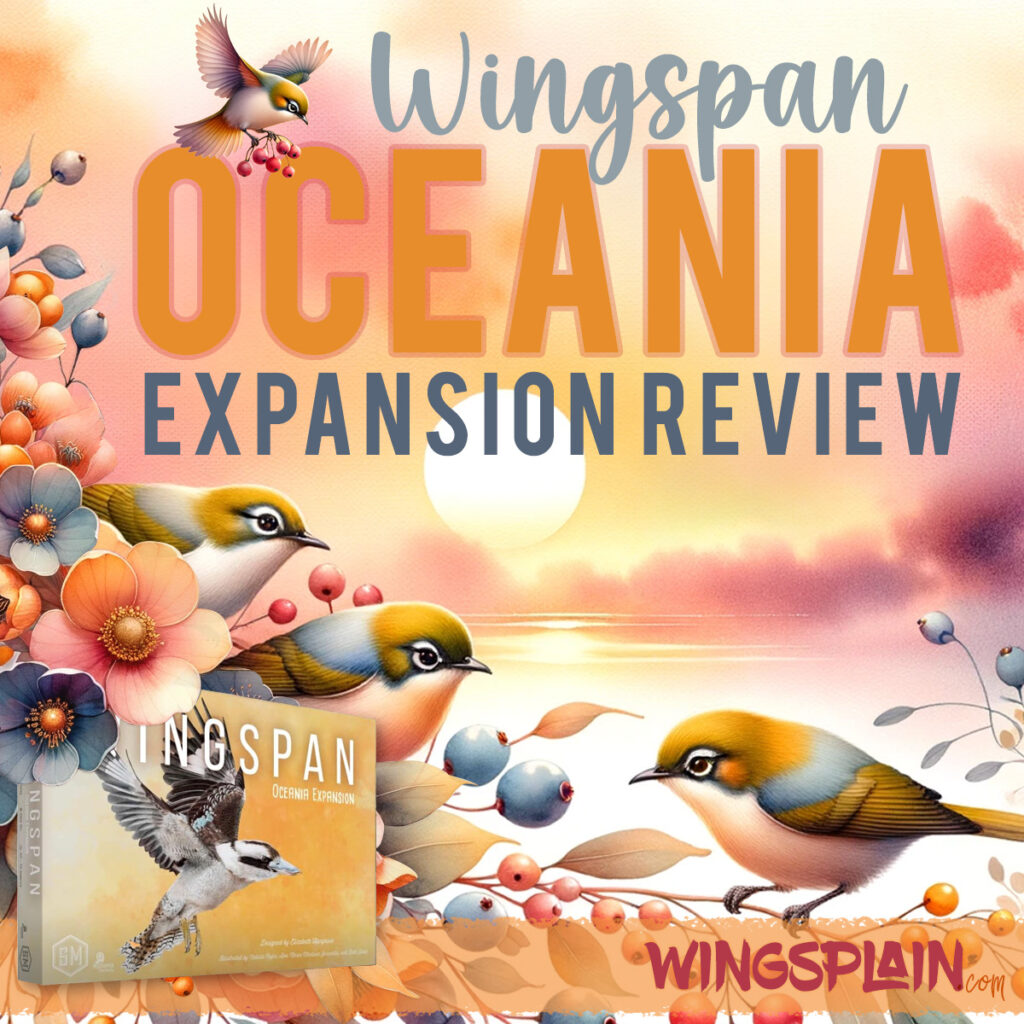Wingspan Oceania Expansion Review
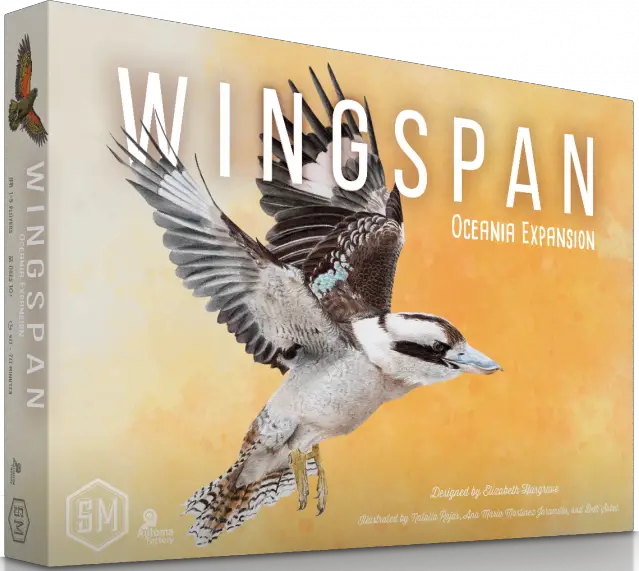
The Oceania Expansion is the second expansion for the hit board game Wingspan. It takes a sharp turn away from the core Wingspan experience and seeks to shake things up by not only restructuring the actions in each habitat but also by introducing an additional food type in nectar.
This expansion was the first to debut Game End Yellow Powers. It does not include any Round End Teal Powers, which were first introduced in Oceania’s predecessor, the European Expansion.
The Theme of the Oceania Expansion
The publicly available Oceania Expansion rulebook and the Designer’s Notes contained therein by the game’s creator, Elizabeth Hargrave, do the theme so much more justice than I can. So I will let that text speak for itself:
Plant-based sugars are an important food source for many birds in Oceania.
In his book, Where Song Began, Biologist Tim Low argues that more nectar is available to birds in Australia than in other parts of the world because, in the region’s poor soils, trees don’t have the nutrients they need to turn sugars into new tissue – so they give it away to pollinators, including honeyeaters and many parrots.
Excess sugars also are available in other forms. When some eucalypts are attacked by insects, the insects exude a sweet substance called manna. Other insects excrete excess sugar from tree sap as substances known as lerp and honeydew. A wide variety of birds in the region, from silvereyes to malleefowl, eat at least one of these sources of sugar.
To represent this abundant sugar in all its forms, this expansion introduces nectar as a new food type and replaces the dice in the birdfeeder with new ones that provide nectar.
Designer’s Notes (Elizabeth Hargrave speaking):
The abundance of plant-based sugar doesn’t just support birds. It attracts a wide variety of insects and mammals. And eventually, the pollinated flowers turn into fruits or seeds. It’s this role in the ecosystem that led me to make nectar wild- not only do many birds eat nectar or lerp directly, but other birds might find the food they’re looking for as a direct result of the presence of nectar. When you feed nectar to a hawk, imagine it finding a sugar glider in a flowering eucalyptus!
Quite frankly, this is a great explanation of nectar and the overall theme of the Oceania Expansion. It explains why the new dice included with the game have a split-faced nectar/fruit side and a split-faced nectar/seed side. It explains why it does make some sense that you would use nectar to cover the rat cost of your Red-Shouldered Hawk. Because that’s how the food chain works in the real world.
I wanted to highlight this text from the rulebook because I think it does an excellent job of bringing context to the expansion which in turn deflates some of the criticisms I’ve seen leveled against it.
What is Nectar and How Does it Affect Gameplay?

Nectar is a wild food source that can be used in place of any other food type in a bird’s cost or any power that has the wild food symbol. Note that if a bird’s power says that you have to discard a specific food type for an effect, you must discard that food type. Nectar cannot be substituted here.
Whenever you spend nectar by playing a bird, discard nectar for a bonus conversion, or as an appropriate cost of a power, you place that nectar on the “Spent Nectar” space of the appropriate habitat that it was spent in. Unspent nectar in your personal supply is discarded to the general supply at the end of each round, so make sure you find a way to use it.
Nectar scoring is handled just like scoring for round goals but it will always result in five points for first place and two points for second place. Everyone else gets zero points. This creates a scenario where players feel pressure to chase an extra fifteen points. It’s an interesting new game element and gives players something new to compete for.
Nectar and its implementation drew some vocal criticism in the days after the expansion’s release (and still does to this day). Some people expressed their concerns that the game becomes “all about nectar” and it detracts from what made Wingspan great. What I refer to as “the core Wingspan experience.”
Others lament that the fruit food type becomes “pointless” since it only exists on a split-face side of the dice, sharing that space with nectar. After all, why choose fruit when nectar is wild? This has sparked the creation of a variety of different house rules.
Personally, I don’t see a problem with nectar or the food dice in this expansion. In all the games I’ve played, I’ve never found myself in a position where I was negatively impacted by having a choice between nectar or fruit. I gladly take the Nectar every time. There will be occasions where you decide to take food toward the end of the round and you will not take Nectar.
It has a time limit each round, and gaining it for the sake of gaining it is a fruitless effort. You can’t stockpile it for point bombing in the closing turns of the game. This “nectar clock” will influence your decisions each round. You must capitalize on it in some fashion otherwise your actions to acquire it will have been pointless.
Overall, nectar has a very interesting impact on the game. It reduces some of the decision-making elements of manipulating the bird feeder since it will always cover that missing food that you need. It generally gives further advantage to the forest habitat that was already improved on the new boards. This makes it much easier to play bird cards in a game about playing bird cards.
That fits with the overall theme of Wingspan and makes sense in that regard. The game feels faster and average scores are generally inflated when nectar is used. Scores will break 100 much more often but this isn’t solely caused by nectar alone.
Wingspan Oceania Expansion Player Boards
One of the criticisms leveled at core Wingspan is that it’s “all about eggs” at the end of the game. What people mean by this is in the closing turns of round four, you will usually (not always) score the most points by taking the Lay Eggs action and running your grasslands engine multiple times in a row through the end of the game.
Make no mistake, this makes sense in the context of an engine-building game where you spend your play session trying to build up your game state and then ending it by harvesting points as efficiently as possible.
In Wingspan, “egg spam” happens because eggs are inherently worth one point each. Food and cards are not. If there are only four turns left in the game, why spend three actions to draw cards, gain food, and play a bird for nine points when you could have just laid eggs and scored fifteen points over those three turns instead?
Playing birds is an important element of every Wingspan game but it is not the only element. I think new plays sometimes miss this part of Wingspan’s design.
I also think that Elizabeth Hargrave heard the critical feedback and took it to heart. She redesigned the player boards so that the Forest and Wetlands gain more resources sooner and the Grasslands generate fewer eggs for most of the game.
The bonus conversions in the Grasslands allow you to spend excess food and/or cards for extra eggs, which are points. There is a new option in the forest to discard one food and reset/reroll all the birdfeeder dice. There is a new option in the wetlands to discard one food and reset the bird card tray. With a lot more food and cards being thrown around in general, there should be at least a handful of opportunities to utilize bonus conversions as well as the new “reset” options.
All things considered, I think the rebalancing went a bit too far in the direction of the forest. Not only does the forest produce more food, but it is organically the best way to acquire nectar, which is a common food type on the new dice.
Even a weak forest engine will produce a decent amount of nectar since it is a common food type on the new dice. Grassland and wetland engines by comparison will struggle to keep up with not only general food production, but they will also struggle to compete for nectar scoring in each habitat. This forces everyone to invest in the forest to some degree in most circumstances.
If you happen to play a bird that can lay eggs in the forest you are in a very powerful position that will allow you to ignore the grasslands entirely, much in the same way that Ravens allow you to ignore the forest. Veterans of the game know how powerful that is.
In a way, nectar feels more powerful than eggs. Filling columns one, two, and three will only cost you six eggs for nine birds played. A forest engine with an egg-laying bird will easily produce a ton of food and the minimal amount of eggs needed to play those birds.
Furthermore, discarding nectar for eggs through bonus conversions feels like a bit of a double whammy since you get your eggs and simultaneously pressure nectar scoring in the grasslands.
I’ve developed the opinion that nectar should score on a 3/2/1 scale instead of the 5/2/0 scale. Ties should award full points (a concept introduced in Wingspan Asia). This lessens the impact of one player securing a disproportionate amount of nectar by spreading the points around multiple players a bit more generously.
It also gives a little something to people at higher player counts who managed to get some nectar down but didn’t manage to get first or second place. This follows the scoring conventions of round goals more closely as third place scores minimal points after round one.
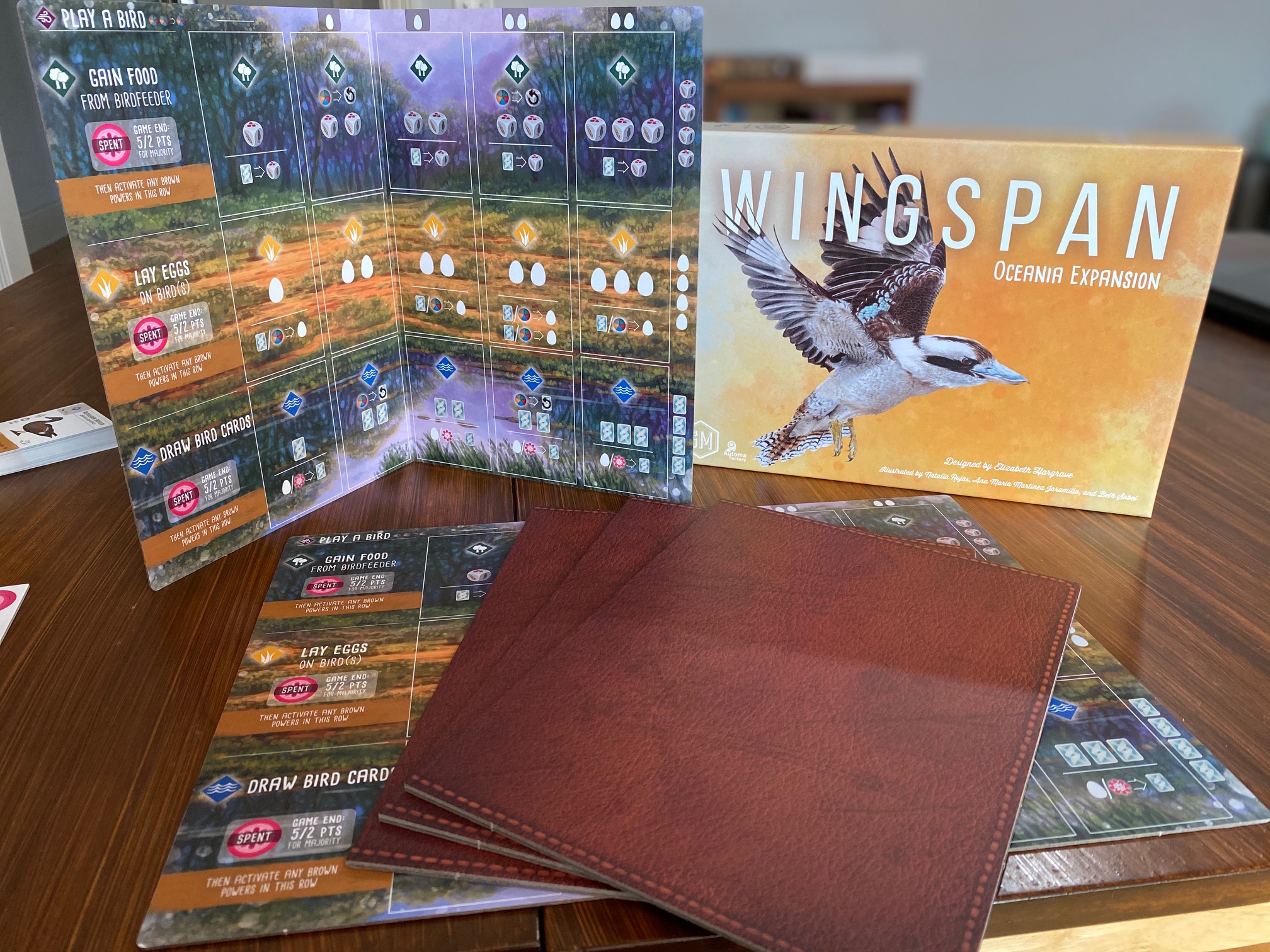
Engine Building Isn’t As Important
If you want to lay fewer eggs and play more birds in Wingspan, this is the expansion for you. Expensive birds are much easier to get onto the board thanks to increased food production from the forest and the fact that everyone starts the game with one free piece of nectar.
This makes it easier to get those three food cost birds into play as early as turn one. Consequently, this tends to make low-value birds with strong brown powers (good engine-building birds) less effective uses of your actions.
Birds that cost three food are excellent “nectar delivery systems.” If you use three nectar to play an expensive bird, that’s three more nectar to help you fight for five extra points in that habitat. Expensive birds played with nectar can end up being even bigger bombs than you may have initially thought when you win those extra five points.
With an increased amount of birds on the board, bonus cards and the birds that draw them become much more valuable. Round goals become much more contested. In practice, you will find that average scores will generally increase by quite a bit despite a shift away from engine building.
100 points is much easier to attain with this expansion and you don’t need a high volume of brown powers or strong egg production to get there. This is a fundamental change from the way the Core Set and the European Expansion play.
Egg-laying brown powers become much stronger though. This makes sense in a metagame that has slower egg production. Forest egg-laying birds are ultra-premium and even grassland egg-laying birds feel like they received a boost in power. They help you build the grasslands back toward their former glory and I find them more consistently useful on the new boards.
Bonus Cards and Round Goals
This expansion introduces five new bonus cards. I think the three “Data Analyst” cards are hard to take advantage of.
In order to score points, you need to have at least three birds with either ascending or descending wingspans in the same habitat. If you managed to pull this off with five birds, you score the maximum five points.
These bonus cards require that you see them as early as possible to plan around them effectively. The later you draw them, the less effective they will be at scoring points. You only have twenty-six actions in the game (a few more with the No Goal round goal in play) and you need as much information as you can get as early as you can get it to make the most informed decisions.
Seeing these cards in the late game could very likely be a guaranteed zero points unless you try to play your birds in the correct order under the assumption that you may see these bonus cards.
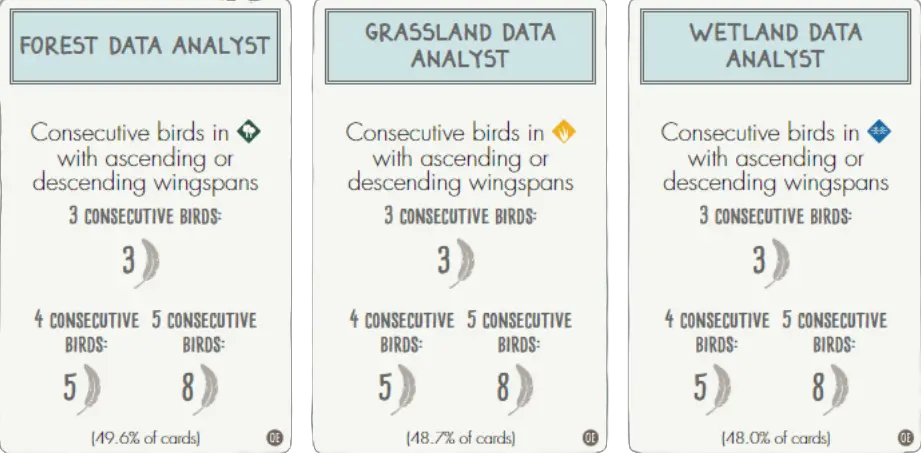
Mechanical Engineer is the exact opposite of the Data Analyst cards. It’s nearly a “free” eight points since it is fairly easy to get two of each nest type on the board organically, no matter what you end up doing. Star nests make this even easier to attain.
Site Selection Expert is harder to pull off but I find it is a more fun puzzle to try and solve than the Data Analyst cards are. You also want this card as early as possible so you can plan appropriately.
Still, this bonus card may force you to play in a sub-optimal manner to meet its requirements of lining up the same nest type in each column. Star nests once again play a major role in helping this bonus card work effectively.
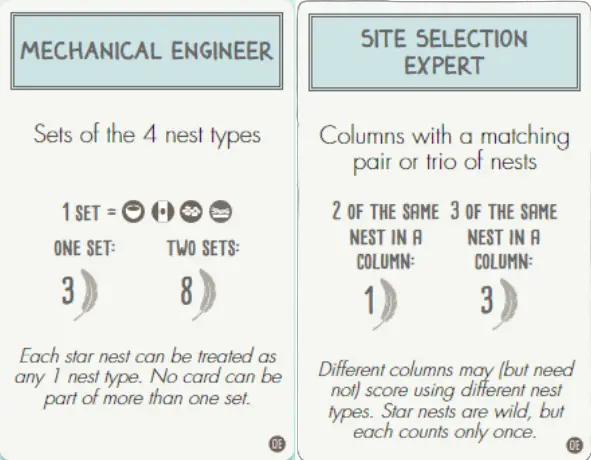
The round goals introduced in this expansion add some interesting new variety to the game and I am happy with them. I won’t go into too much detail here other than to mention that none of them check eggs, further steering the metagame away from egg production.
The “No Goal” goal is an interesting addition to the game. It’s a popular house rule to always use this as the round one goal. This results in three more turns by the end of the game since you don’t place an action cube on the scoreboard at the end of the round and subsequently carry that action cube into future rounds.

Game End Yellow Powers Are A Mixed Bag
Overall, I’m lukewarm on most of the yellow powers. Half of them (eight of sixteen) involve laying eggs on birds with specific qualities. This can be effective with the right setup.
Three powers let you play another bird and these are pretty good. Three let you cache food. One of them lets you tuck one card from the deck under each bird in your grasslands. One of them lets you look at four bonus cards at the end of the game and keep one of them. This one is amazing!
Automa
I have not played with any of the new Automa gameplay elements from this expansion. I personally don’t play with the Automa that often, and when I do, it’s through the digital adaption of the game by Monster Couch. This is because the game mode is automated by the computer and it’s a much more enjoyable experience for me. Once they fully implement this expansion digitally and I get time with the Automa, I will update this review accordingly.
Looking over the Automa rulebook, they have added a scorecard for the Automa to take advantage of nectar which I think is pretty cool. They’ve also added two new game variants: Automa’s Hoard and Automarazzi.
Automa’s Hoard is an interesting concept. The designer’s notes indicate that with the increase in the amount of bird powers that share resources, they wanted the Automa to gain some type of benefit. This makes sense to me because sharing powers are overpowered against the Automa, which traditionally gets nothing from them while you get all the benefits.
Automarazzi allows 2-4 players to team up against the Auotma. The designer’s notes indicated that this variant “offers a simple set of rules designed to provide a relaxed experience of playing together against a common opponent instead of competitively against one another.”
Both variants can be used together and with any combination of expansions. They do not recommend using Automa’s Hoard with just the base game alone, since there will be fewer sharing powers without Oceania in the mix.
Component Quality
The quality of the components in this expansion is top-notch as usual. I have no complaints here. I think Wingspan and its expansions are well made and their look and feel are key elements of Wingspan’s overall charm.
Wingspan Oceania includes:
- Five new player boards
- 69 nectar tokens
- 5 new food dice
- 15 yellow eggs
- 1 reference tile
- 4 round goal tiles (double-sided)
- 1 score pad
- 5 bonus cards
- 95 bird cards
- 1 rule book
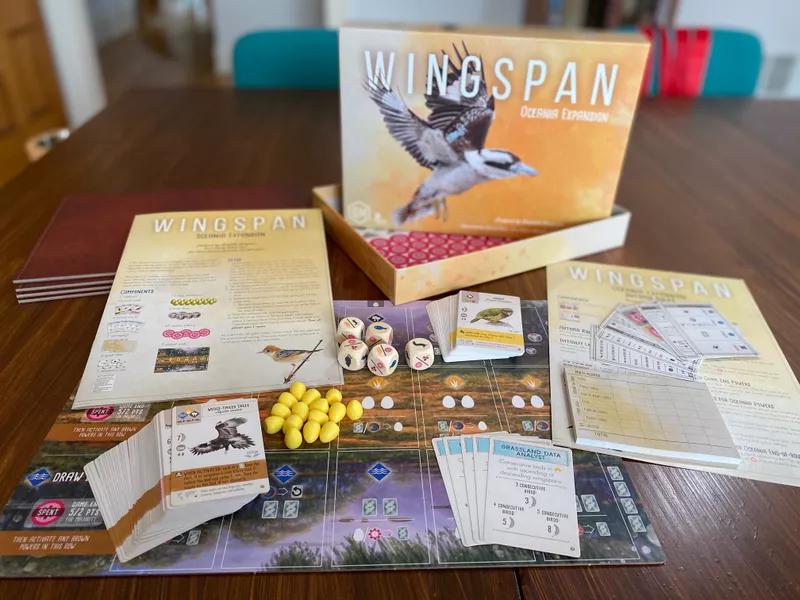
Wingspan Oceania Expansion Review: Final Thoughts
I really enjoy the Wingspan Oceania Expansion and I think it works very well. I would recommend it to anyone but I would probably warn people about how it shakes up the core Wingspan experience and it may take some getting used to.
I think the re-balancing of the boards was a bit of an over-correction toward the forest. I think the nerf to grasslands egg production went slightly too far in the face of the increased productivity of the forest combined with nectar scoring.
The re-balanced wetlands work very well in practice. It reduces the importance of getting a strong card-drawing bird into column one but doesn’t totally eliminate it. It also serves to curb the power of card drawing birds that can be played outside of the wetlands such as Killdeer, Franklin’s Gull, White Stork, and Wood Duck. Although reduced grassland egg production does hurt grassland card drawing birds as well.
The new bird powers are fun and interesting. Predator powers have improved across the board and big point predators have more interesting powers in general. Some yellow powers feel a bit underwhelming though.
I’ve never found myself disliking nectar. Its presence reduces the luck element of dice rolls and the improved forest habitat facilitates a birdfeeder that cycles much more often. Nectar scoring adds another strategic element to the game that I enjoy paying attention to and planning around.
Some images were taken from Wingsearch, Rulepop, and Stonemaier Games. Be sure to check out these amazing player resources as well as Stonemaier Games.
